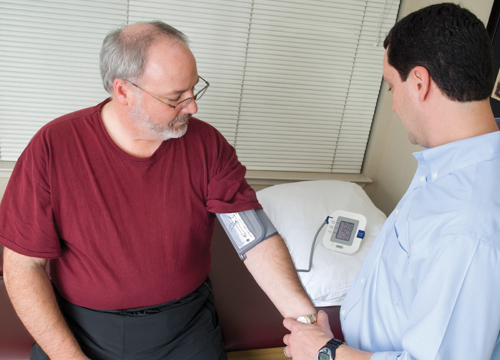In-depth

Diabetes denial
In In-depth
Bookmark
Record learning outcomes
Diabetes is a growing problem in the UK, but particularly so for men who are more likely to develop the disease than women and more likely to experience life-changing or even life-ending consequences. The up-side is that pharmacy interventions can help
There are currently 3.4 million people with type 2 diabetes in England and around 200,000 new diagnoses every year. Despite its prevalence, new research by Diabetes UK suggests that the lifelong condition – where the body’s glucose level is too high – is not taken seriously by the UK public.

The charity surveyed 1,000 people with and without a link to diabetes and discovered that no one knew that diabetes could cause problems in pregnancy, only two per cent knew diabetes could lead to a shorter life span, and only four per cent knew it could lead to premature death.
In fact, NHS England figures show around 22,000 people with diabetes die prematurely every year. What’s more, type 2 diabetes is a leading cause of preventable sight loss in people of working age (see page 12) and is a major contributor to kidney failure, heart attack, and stroke. While type 1 diabetes cannot be prevented and is not linked to lifestyle, there are currently five million people in England at high risk of developing type 2 diabetes, which is largely preventable through lifestyle changes.
While this message can be difficult to get across to people, the additional challenge here is convincing men – notoriously harder to reach with self care messages – to address their unhealthy habits. Not only are men more likely to develop diabetes than women, they are also more likely to experience life-changing or even life-ending consequences because of it. Shockingly, the latest research from the Men’s Health Forum has revealed that one man in 10 now has type 1 or type 2 diabetes, and predicts a tripling in the incidence of type 2 diabetes in middle-aged men for the next 30 years.
Men more at risk
The Men’s Health Forum’s new report One In Ten: The Male Diabetes Crisis shows that men are 26 per cent more likely to develop type 2 diabetes than women and are 40 per cent more likely than women to die from the disease.
So what are the reasons for these inequalities between men and women?
According to the Men’s Health Forum, men are more likely to be overweight (with a BMI of 25 or over) and to develop diabetes at a lower BMI than women, but they are also less likely to be aware that they are overweight or participate in weight management programmes. When it comes to complications, men are also more likely to suffer from diabetic retinopathy; 69.6 per cent of those presenting with a diabetic foot ulcer are men; and men are more than twice as likely as women to have a major amputation.
And then there is “the obstacle of resistance to accepting they have diabetes”, according to Bernadette Brown, community pharmacy owner and clinical independent prescribing pharmacist at Cadham Pharmacy Health Centre in Fife, where she and her team run a diabetes testing clinic.
“Here’s an example,” says Bernadette. “I’ve got a 55-year-old male customer who is representative of a typical diabetic man. He was diagnosed 10 years ago, but when I saw him recently his HbA1c glycated haemoglobin level (which gives an overall picture of average blood sugar levels over time) was dangerously high. He’d been on metformin but said he’d stopped taking it because it was giving him ‘the runs’ and apart from feeling a bit tired and needing to go to the loo a lot he felt he was ‘well enough’, holding down a full-time job and golfing twice a week, and didn’t really feel
he had diabetes.
“He’d made this his new normal, so I realised I needed to explain to him what normal really looked like in a man of his age who didn’t have diabetes. As it happens he’s quite a competitive chap, so that comparison appealed to him as a motivator to get his levels down. I also put his medicines in a nomad pack to make it as simple as possible for him to take them, and in six weeks his HbA1c level came down, he began to feel more energised so he could up his physical activity, and he finally accepted that he had diabetes – which is half the battle for managing it.”
Team support
Bernadette says counter staff “can support pharmacists to have these conversations, particularly when someone comes in with symptoms”, but there is also plenty that pharmacy teams can do to help men identify and reduce their risk of developing type 2 diabetes in the first place.
Type 2 diabetes can come on slowly, usually over the age of 40, and the signs may not be obvious. Diabetes UK stresses that it can take up to 10 years before someone finds out they have diabetes, which is why it is important that people know the risk factors so they can do something about it.
As well as being male you are more at risk of developing diabetes if you’re white and over 40, or over 25 if you’re African-Caribbean, black African, or South Asian – type 2 diabetes is two to four times more likely in people of South Asian descent and African-Caribbean or black African descent.
People are two to six times more likely to get type 2 diabetes if they have a parent, brother, sister or child with diabetes, and people are more at risk if they have ever had a heart attack or a stroke; have schizophrenia, bipolar illness or depression; or if they are receiving treatment with antipsychotic medication.
Reducing risk
The risk of developing type 2 diabetes is greater if people have high blood pressure or are overweight, especially if they are large around the stomach. This opens up another opportunity for pharmacy teams to talk to people about weight management and healthy eating.
Nutritionist Dr Emma Derbyshire suggests that counter staff: “Continue to advise men to attain a healthy body weight and keep their alcohol intakes in check. You also need to get them to reflect on their daily sugar intakes which should be no more than 30 grams per day (seven teaspoons). Currently intakes are about twice this, so switching to sweeteners will cut sugar intakes hugely.”
The Men’s Health Forum also calls for better engagement of men in weight management programmes, as well as in NHS Health Checks, routine eye tests, and diabetes education programmes, which it says “must be designed and delivered in ways that work for men”.
Usefully, pharmacists are among the health professionals who can refer people at risk of type 2 diabetes to The Healthier You: NHS Diabetes Prevention Programme (NHS DPP) – a joint initiative from NHS England, Public Health England and Diabetes UK that identifies those at high risk and refers them to a behaviour change programme.
Those referred to the service receive tailored, personalised support to reduce their risk of type 2 diabetes including education on healthy eating and lifestyle, help to lose weight and physical exercise programmes, which together have been proven to reduce the risk of developing the disease.
How the NHS Health Check can help

The free NHS Health Check for adults in England aged 40-74 is designed to spot early signs of type 2 diabetes, as well as stroke, kidney disease, heart disease and dementia. Encouraging men to have the check will enable them to take steps earlier to prevent or even reverse type 2 diabetes caught in its early stages.
Although men may be reticent to book an appointment, Pav Kalsi, senior clinical advisor at Diabetes UK, says pharmacy teams can reassure them that it’s a straightforward procedure: “It involves being asked some simple questions about lifestyle, family history, checking weight, blood pressure and getting a blood test to help work out your chances of getting heart disease, stroke, kidney disease and type 2 diabetes. They will then receive personalised advice to lower their risk, such as how to improve diet and the amount of physical activity they do, how to lose weight, stop smoking, and what medicines they need to take,” she says.
However, Pav also warns that “many people may already have type 2 diabetes without realising it. Symptoms to be aware of are urinating often, feeling very thirsty, extreme fatigue, blurry vision, slow-healing cuts and bruises and pain, or numbness in the hands and/or feet. They may put down the above symptoms to other things, like leading a busy life.” These are all signs that pharmacy teams can look out for.
Keep talking
Tackling diabetes was also the theme of June’s Men’s Health Week, for which the Men’s Health Forum produced a ‘Man Manual’ to inform and advise men about the risks, prevention and management of type 2 diabetes. The straightforward handbook explains the condition, how diet and physical activity can help, and addresses common questions such as how the condition can affect sex, and how diabetes is treated.
Although this particular event has passed, Emma says pharmacy teams have “an important role to play” in promoting awareness weeks to men, particularly as “preventative strategies are fundamentally important in helping to preserve health and keep NHS costs down.”
And Pav Kalsi, senior clinical advisor at Diabetes UK, says “men may not always be good at going to appointments”, but suggests that holding “pharmacy and workplace health events are a useful way to engage with men to raise awareness of diabetes, its symptoms and the seriousness of it. Also, it’s easy to offer a check-up to work out their risk of developing type 2 diabetes, and signpost to services and support available in the local area”.
World Diabetes Day on November 14 – the birthday of Sir Frederick Banting, who co-discovered insulin along with Charles Best in 1922 – offers another opportunity to reach out to men in the local community. This year’s theme, The Family and Diabetes, aims to raise awareness of the impact that diabetes has on the family and support networks of those affected.
With early diagnosis and treatment key to preventing the complications of diabetes and achieving healthy outcomes, stressing the effect that a diagnosis of diabetes could have on a man’s wider family could be the trigger that gets his attention and encourages him to address his risk.
Around 22,000 people with diabetes die prematurely every year
